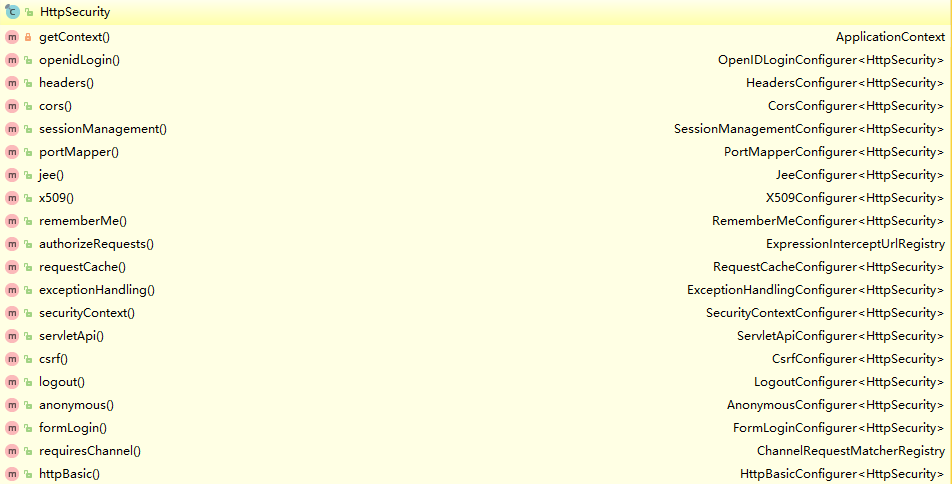3 核心配置解读
3.1 功能介绍
这是 Spring Security 入门指南中的配置项:
@Configuration
@EnableWebSecurity
public class WebSecurityConfig extends WebSecurityConfigurerAdapter {
@Override
protected void configure(HttpSecurity http) throws Exception {
http
.authorizeRequests()
.antMatchers("/", "/home","/logout").permitAll()
.anyRequest().authenticated()
.and()
.formLogin()
.loginPage("/login")
.permitAll()
.and()
.logout()
.permitAll();
}
@Autowired
public void configureGlobal(AuthenticationManagerBuilder auth) throws Exception {
auth
.inMemoryAuthentication()
.withUser("admin").password("admin").roles("USER");
}
}当配置了上述的 javaconfig 之后,我们的应用便具备了如下的功能:
除了“/”,”/home”(首页),”/login”(登录),”/logout”(注销), 之外,其他路径都需要认证。
指定“/login”该路径为登录页面,当未认证的用户尝试访问任何受保护的资源时,都会跳转到“/login”。
默认指定“/logout”为注销页面
配置一个内存中的用户认证器,使用 admin/admin 作为用户名和密码,具有 USER 角色
防止 CSRF 攻击
Session Fixation protection(可以参考我之前讲解 Spring Session 的文章,防止别人篡改 sessionId)
Security Header(添加一系列和 Header 相关的控制)
- HTTP Strict Transport Security for secure requests
- 集成 X-Content-Type-Options
- 缓存控制
- 集成 X-XSS-Protection
- X-Frame-Options integration to help prevent Clickjacking(iframe 被默认禁止使用)
为 Servlet API 集成了如下的几个方法
- HttpServletRequest#getRemoteUser()
- HttpServletRequest.html#getUserPrincipal()
- HttpServletRequest.html#isUserInRole(java.lang.String)
- [HttpServletRequest.html#login(java.lang.String, java.lang.String)](https://docs.oracle.com/javaee/6/api/javax/servlet/http/HttpServletRequest.html#login(java.lang.String, java.lang.String))
- HttpServletRequest.html#logout()
3.2 @EnableWebSecurity
我们自己定义的配置类 WebSecurityConfig 加上了 @EnableWebSecurity 注解,同时继承了 WebSecurityConfigurerAdapter。你可能会在想谁的作用大一点,毫无疑问 @EnableWebSecurity 起到决定性的配置作用,它其实是个组合注解。
@Import({ WebSecurityConfiguration.class, // <2>
SpringWebMvcImportSelector.class }) // <1>
@EnableGlobalAuthentication // <3>
@Configuration
public @interface EnableWebSecurity {
boolean debug() default false;
}@Import 是 springboot 提供的用于引入外部的配置的注解,可以理解为:@EnableWebSecurity 注解激活了 @Import 注解中包含的配置类。
<1> SpringWebMvcImportSelector 的作用是判断当前的环境是否包含 springmvc,因为 spring security 可以在非 spring 环境下使用,为了避免 DispatcherServlet 的重复配置,所以使用了这个注解来区分。
<2> WebSecurityConfiguration 顾名思义,是用来配置 web 安全的,下面的小节会详细介绍。
<3> @EnableGlobalAuthentication 注解的源码如下:
@Import(AuthenticationConfiguration.class)
@Configuration
public @interface EnableGlobalAuthentication {
}注意点同样在 @Import 之中,它实际上激活了 AuthenticationConfiguration 这样的一个配置类,用来配置认证相关的核心类。
也就是说:@EnableWebSecurity 完成的工作便是加载了 WebSecurityConfiguration,AuthenticationConfiguration 这两个核心配置类,也就此将 spring security 的职责划分为了配置安全信息,配置认证信息两部分。
WebSecurityConfiguration
在这个配置类中,有一个非常重要的 Bean 被注册了。
@Configuration
public class WebSecurityConfiguration {
//DEFAULT_FILTER_NAME = "springSecurityFilterChain"
@Bean(name = AbstractSecurityWebApplicationInitializer.DEFAULT_FILTER_NAME)
public Filter springSecurityFilterChain() throws Exception {
...
}
}在未使用 springboot 之前,大多数人都应该对“springSecurityFilterChain”这个名词不会陌生,他是 spring security 的核心过滤器,是整个认证的入口。在曾经的 XML 配置中,想要启用 spring security,需要在 web.xml 中进行如下配置:
<!-- Spring Security -->
<filter>
<filter-name>springSecurityFilterChain</filter-name>
<filter-class>org.springframework.web.filter.DelegatingFilterProxy</filter-class>
</filter>
<filter-mapping>
<filter-name>springSecurityFilterChain</filter-name>
<url-pattern>/*</url-pattern>
</filter-mapping>而在 springboot 集成之后,这样的 XML 被 java 配置取代。WebSecurityConfiguration 中完成了声明 springSecurityFilterChain 的作用,并且最终交给 DelegatingFilterProxy 这个代理类,负责拦截请求(注意 DelegatingFilterProxy 这个类不是 spring security 包中的,而是存在于 web 包中,spring 使用了代理模式来实现安全过滤的解耦)。
AuthenticationConfiguration
@Configuration
@Import(ObjectPostProcessorConfiguration.class)
public class AuthenticationConfiguration {
@Bean
public AuthenticationManagerBuilder authenticationManagerBuilder(
ObjectPostProcessor<Object> objectPostProcessor) {
return new AuthenticationManagerBuilder(objectPostProcessor);
}
public AuthenticationManager getAuthenticationManager() throws Exception {
...
}
}AuthenticationConfiguration 的主要任务,便是负责生成全局的身份认证管理者 AuthenticationManager。还记得在《Spring Security(一)–Architecture Overview》中,介绍了 Spring Security 的认证体系,AuthenticationManager 便是最核心的身份认证管理器。
3.3 WebSecurityConfigurerAdapter
适配器模式在 spring 中被广泛的使用,在配置中使用 Adapter 的好处便是,我们可以选择性的配置想要修改的那一部分配置,而不用覆盖其他不相关的配置。WebSecurityConfigurerAdapter 中我们可以选择自己想要修改的内容,来进行重写,而其提供了三个 configure 重载方法,是我们主要关心的:

由参数就可以知道,分别是对 AuthenticationManagerBuilder,WebSecurity,HttpSecurity 进行个性化的配置。
HttpSecurity 常用配置
@Configuration
@EnableWebSecurity
public class CustomWebSecurityConfig extends WebSecurityConfigurerAdapter {
@Override
protected void configure(HttpSecurity http) throws Exception {
http
.authorizeRequests()
.antMatchers("/resources/**", "/signup", "/about").permitAll()
.antMatchers("/admin/**").hasRole("ADMIN")
.antMatchers("/db/**").access("hasRole('ADMIN') and hasRole('DBA')")
.anyRequest().authenticated()
.and()
.formLogin()
.usernameParameter("username")
.passwordParameter("password")
.failureForwardUrl("/login?error")
.loginPage("/login")
.permitAll()
.and()
.logout()
.logoutUrl("/logout")
.logoutSuccessUrl("/index")
.permitAll()
.and()
.httpBasic()
.disable();
}
}上述是一个使用 Java Configuration 配置 HttpSecurity 的典型配置,其中 http 作为根开始配置,每一个 and()对应了一个模块的配置(等同于 xml 配置中的结束标签),并且 and() 返回了 HttpSecurity 本身,于是可以连续进行配置。他们配置的含义也非常容易通过变量本身来推测,
- authorizeRequests() 配置路径拦截,表明路径访问所对应的权限,角色,认证信息。
- formLogin() 对应表单认证相关的配置
- logout() 对应了注销相关的配置
- httpBasic() 可以配置 basic 登录
- etc
他们分别代表了 http 请求相关的安全配置,这些配置项无一例外的返回了 Configurer 类,而所有的 http 相关配置可以通过查看 HttpSecurity 的主要方法得知:

需要对 http 协议有一定的了解才能完全掌握所有的配置,不过,springboot 和 spring security 的自动配置已经足够使用了。其中每一项 Configurer(e.g.FormLoginConfigurer,CsrfConfigurer)都是 HttpConfigurer 的细化配置项。
WebSecurityBuilder
@Configuration
@EnableWebSecurity
public class WebSecurityConfig extends WebSecurityConfigurerAdapter {
@Override
public void configure(WebSecurity web) throws Exception {
web
.ignoring()
.antMatchers("/resources/**");
}
}以笔者的经验,这个配置中并不会出现太多的配置信息。
AuthenticationManagerBuilder
@Configuration
@EnableWebSecurity
public class WebSecurityConfig extends WebSecurityConfigurerAdapter {
@Override
protected void configure(AuthenticationManagerBuilder auth) throws Exception {
auth
.inMemoryAuthentication()
.withUser("admin").password("admin").roles("USER");
}
}想要在 WebSecurityConfigurerAdapter 中进行认证相关的配置,可以使用 configure(AuthenticationManagerBuilder auth) 暴露一个 AuthenticationManager 的建造器:AuthenticationManagerBuilder 。如上所示,我们便完成了内存中用户的配置。
细心的朋友会发现,在前面的文章中我们配置内存中的用户时,似乎不是这么配置的,而是:
@Configuration
@EnableWebSecurity
public class WebSecurityConfig extends WebSecurityConfigurerAdapter {
@Autowired
public void configureGlobal(AuthenticationManagerBuilder auth) throws Exception {
auth
.inMemoryAuthentication()
.withUser("admin").password("admin").roles("USER");
}
}如果你的应用只有唯一一个 WebSecurityConfigurerAdapter,那么他们之间的差距可以被忽略,从方法名可以看出两者的区别:使用 @Autowired 注入的 AuthenticationManagerBuilder 是全局的身份认证器,作用域可以跨越多个 WebSecurityConfigurerAdapter,以及影响到基于 Method 的安全控制;而 protected configure() 的方式则类似于一个匿名内部类,它的作用域局限于一个 WebSecurityConfigurerAdapter 内部。关于这一点的区别,可以参考我曾经提出的 issuespring-security#issues4571。官方文档中,也给出了配置多个 WebSecurityConfigurerAdapter 的场景以及 demo,将在该系列的后续文章中解读。
本博客所有文章除特别声明外,均采用 CC BY-SA 4.0 协议 ,转载请注明出处!